 Bài giảng môn Quản trị cơ sở dữ liệu
Bài giảng môn Quản trị cơ sở dữ liệuVì sao cần có hệ QTCSDL? Trình bày và so sánh một số hệ QT CSDL thông dụng? • SQL Server có những phiên bản nào? So sánh tính năng của từng phiên bản? • Các đối tượng sử dụng trong SQL Server? • Các thành phần chính trong T-SQL? • Hoạt động của ngôn ngữ T-SQL? • Index là gì? Vì sao cần dùng index trong quản trị CSDL? Cách tạo Index? • Phân...
 24 trang | Chia sẻ: huongthu9 | Ngày: 17/08/2021 | Lượt xem: 1064 | Lượt tải: 0
24 trang | Chia sẻ: huongthu9 | Ngày: 17/08/2021 | Lượt xem: 1064 | Lượt tải: 0 Bài giảng cơ sở dữ liệu - Bài 4: Tối ưu truy vấn trên hệ cơ sở dữ liệu phân tán - Đỗ Phúc
Bài giảng cơ sở dữ liệu - Bài 4: Tối ưu truy vấn trên hệ cơ sở dữ liệu phân tán - Đỗ PhúcBegin SJ ← most_benefit(BS) BS ← BS – SJ ES ← ES + SJ sửa lại số liệu thống kê để phản ánh tác dụng của việc gắn SJ BS ← BS – các nối nửa không lợi ích BS ← BS ∪ các nối nửa lợi ích mới End While; AS(ES) ← chọn vị trí i sao cho i có chứa dữ liệu lớn nhất sau khi thực hiện tất cả mọi thao tác cục bộ ES ← ES ∪ truyền các quan hệ trung gian ...
 49 trang | Chia sẻ: huongthu9 | Ngày: 17/08/2021 | Lượt xem: 795 | Lượt tải: 0
49 trang | Chia sẻ: huongthu9 | Ngày: 17/08/2021 | Lượt xem: 795 | Lượt tải: 0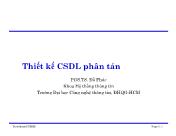 Bài giảng cơ sở dữ liệu - Bài 3: Thiết kế cơ sở dữ liệu phân tán - Đỗ Phúc
Bài giảng cơ sở dữ liệu - Bài 3: Thiết kế cơ sở dữ liệu phân tán - Đỗ PhúcCác phương pháp giải FAP is NP-complete DAP also NP-complete Các Heuristics dựa trên Vị trí kho hoàng duy nhất (for FAP) Bài toán xếp ba lô (knapsack problem) Kỹ thuật nhánh và cận (branch and bound techniques) Bài toán luồng (network flow)
 68 trang | Chia sẻ: huongthu9 | Ngày: 17/08/2021 | Lượt xem: 711 | Lượt tải: 0
68 trang | Chia sẻ: huongthu9 | Ngày: 17/08/2021 | Lượt xem: 711 | Lượt tải: 0 Bài giảng cơ sở dữ liệu - Bài 2: Tổng quan về cơ sở dữ liệu phân tán
Bài giảng cơ sở dữ liệu - Bài 2: Tổng quan về cơ sở dữ liệu phân tánHỗ trợ hệ điều hành Hệ điều hành với hỗ trợ đúng cho các thao tác CSDL Phân chia giữa yêu cầu xử lý với mục tiêu chung và yêu cầu xử lý CSDL Các hệ thống mở và Interoperability Các hệ đa CSDL phân tán Các kịch bản khả dĩ hơn Các vấn đề song song
 55 trang | Chia sẻ: huongthu9 | Ngày: 17/08/2021 | Lượt xem: 822 | Lượt tải: 0
55 trang | Chia sẻ: huongthu9 | Ngày: 17/08/2021 | Lượt xem: 822 | Lượt tải: 0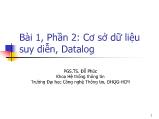 Bài giảng cơ sở dữ liệu - Bài 1, Phần 2 : Cơ sở dữ liệu suy diễn, Datalog
Bài giảng cơ sở dữ liệu - Bài 1, Phần 2 : Cơ sở dữ liệu suy diễn, DatalogMọi mô hình không phải là điểm bất động vì một mô hình có thể có vài sự kiện xuất hiện trong về trái của phương trình Có thể chứng minh mô hình tối thiểu là điểm bất động Mô hình tối thiểu duy nhất P0 là điểm bất động duy nhất
 43 trang | Chia sẻ: huongthu9 | Ngày: 17/08/2021 | Lượt xem: 759 | Lượt tải: 0
43 trang | Chia sẻ: huongthu9 | Ngày: 17/08/2021 | Lượt xem: 759 | Lượt tải: 0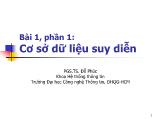 Bài giảng cơ sở dữ liệu - Bài 1: Cơ sở dữ liệu suy diễn
Bài giảng cơ sở dữ liệu - Bài 1: Cơ sở dữ liệu suy diễnXét hai luật: r1: ancestor(X,Y) :- parent(X,Y) r2: ancestor(X,Y) :- parent(X,Z) & ancestor(Z,Y) Với parent(X,Y) là vị từ nền, ancestor(X,Y) là vị từ được suy và các luật có dạng đệ qui. Quan hệ parent(X,Y) ứng với các bộ sau đây: parent(X,Y)={(j,f)(j,h)(k,g)(k,i)(f,c)(f,e)(g,c)(h,d)(i,d) (c,a)(d,a)(d,b)(e,b)} Với đích cần tìm là q...
 25 trang | Chia sẻ: huongthu9 | Ngày: 17/08/2021 | Lượt xem: 995 | Lượt tải: 0
25 trang | Chia sẻ: huongthu9 | Ngày: 17/08/2021 | Lượt xem: 995 | Lượt tải: 0 Bài giảng Access - Chương 1: Xây dựng cơ sở dữ liệu - Nguyễn Sơn Hải
Bài giảng Access - Chương 1: Xây dựng cơ sở dữ liệu - Nguyễn Sơn HảiVí dụ: Thêm một bộ giá trị (“TK”, “Thư ký”, 0.15) vào cuối bảng DMCHUCVU INSERT INTO DMCHUCVU ( MaCV, Tenchucvu, HesoCV ) VALUES ("KT","THU KY",0.15)
 66 trang | Chia sẻ: huongthu9 | Ngày: 17/08/2021 | Lượt xem: 804 | Lượt tải: 0
66 trang | Chia sẻ: huongthu9 | Ngày: 17/08/2021 | Lượt xem: 804 | Lượt tải: 0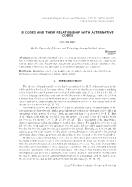 B-Codes and their relationship with alternative codes
B-Codes and their relationship with alternative codesThe purpose of this note was to deal with the development of the classes of b-codes and alternative codes. Four new classes of codes, which are subclasses of b-codes, were introduced and considered. Several characteristics and relationships of these classes were proposed (Theorems 3-4). One of them provided us with a tool to describe the b-codes...
 9 trang | Chia sẻ: huongthu9 | Ngày: 17/08/2021 | Lượt xem: 597 | Lượt tải: 0
9 trang | Chia sẻ: huongthu9 | Ngày: 17/08/2021 | Lượt xem: 597 | Lượt tải: 0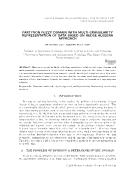 Partition fuzzy domain with multi-Granularity representation of data based on hedge algebra approach
Partition fuzzy domain with multi-Granularity representation of data based on hedge algebra approachThe paper presents the method of mining the association rule according to the hedge algebra’s approach based on dividing the fuzzy domain of the attribute values according to the multi-granularity representation. Experimental results based on the database of the US Census in 1995 showed us the advantage of this method. Firstly, it provides a fai...
 13 trang | Chia sẻ: huongthu9 | Ngày: 17/08/2021 | Lượt xem: 706 | Lượt tải: 0
13 trang | Chia sẻ: huongthu9 | Ngày: 17/08/2021 | Lượt xem: 706 | Lượt tải: 0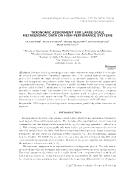 Taxonomic assignment for large-Scale metagenomic data on high-perfomance systems
Taxonomic assignment for large-Scale metagenomic data on high-perfomance systemsMost of current taxonomic assignment algorithms developed to be used on a single computer are difficult to adapt to the increasing of metagenomic data. In this work, we present a parallel taxonomic assignment algorithm to boost the speed of processing large-scale metagenomic sequences. The main idea of SeMetaPL is to reduce costs of the homology...
 12 trang | Chia sẻ: huongthu9 | Ngày: 17/08/2021 | Lượt xem: 666 | Lượt tải: 0
12 trang | Chia sẻ: huongthu9 | Ngày: 17/08/2021 | Lượt xem: 666 | Lượt tải: 0
Copyright © 2025 Tai-Lieu.com - Hướng dẫn học sinh giải bài tập trong SGK, Thư viện sáng kiến kinh nghiệm hay, Thư viện đề thi


